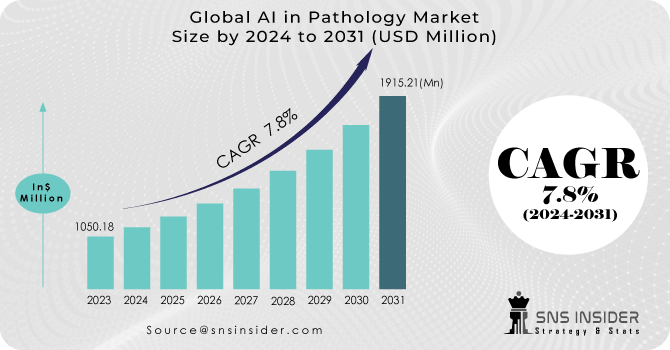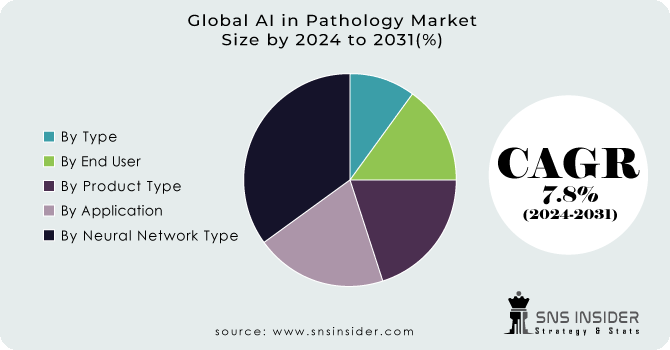AI in Pathology Market Report Scope and Overview:
The AI in Pathology Market size was valued at USD 1220.40 million in 2025E and is expected to grow to USD 2225.62 million by 2033 and grow at a CAGR Of 7.8% over the forecast period of 2026-2033.
With the help of the combination of artificial intelligence pathology, pathologists may now adopt image analytics by analyzing more slides in a shorter amount of time. This can assist pathologists in narrowing their focus and enhancing the effectiveness of their results. With devices and applications having access to electronic health records, radiology pictures, and other data, the use of artificial intelligence in pathology will change the whole patient experience and encourage greater patient engagement.

To Get More Information on AI in Pathology Market - Request Sample Report
AI in Pathology Market Drivers:
-
Enhancements in computer Power and Cloud Infrastructure enable real-time analytics, AI, and scalable data processing, driving innovation and digital transformation
Advancements in computer power and cloud infrastructure have revolutionized the way data-intensive applications are developed and deployed across industries. High-performance processors, GPUs, and specialized AI accelerators now enable complex computations and real-time analytics that were previously impractical. Simultaneously, cloud platforms provide scalable storage, distributed computing, and seamless access to global resources, allowing organizations to handle massive datasets efficiently and cost-effectively. These enhancements support AI, machine learning, and big data workflows, facilitating faster innovation, improved collaboration, and enhanced operational efficiency. Together, increased computing power and cloud scalability are driving a new era of digital transformation and intelligent applications.
AI in Pathology Market Restraints:
-
Standardized, high-quality data ensures accurate analytics, reliable AI, and informed decision-making.
Data quality and standardization are critical for ensuring accurate, reliable, and actionable insights across industries. High-quality data is complete, consistent, and error-free, while standardization ensures uniform formats, definitions, and structures that enable interoperability between systems. Together, they support robust analytics, AI, and machine learning models by reducing bias, improving predictive accuracy, and facilitating seamless data integration. Standardized, high-quality data also enhances decision-making, regulatory compliance, and operational efficiency, allowing organizations to trust insights derived from complex datasets. Ultimately, prioritizing data quality and standardization is essential for unlocking the full potential of digital transformation initiatives.
AI in Pathology Market Opportunities:
-
Workflow automation uses technology and AI to streamline processes, reduce manual effort, improve efficiency, and enhance productivity.
Workflow automation refers to the use of technology to streamline, standardize, and optimize business and operational processes, reducing the need for manual intervention. By leveraging software tools, robotic process automation (RPA), and AI-driven solutions, organizations can execute repetitive tasks faster, more accurately, and consistently. Automation improves efficiency, minimizes errors, and frees employees to focus on higher-value activities, enhancing productivity and operational agility. It also enables real-time monitoring, reporting, and compliance adherence, ensuring processes are transparent and accountable. Across industries, workflow automation accelerates decision-making, reduces operational costs, and supports scalable, flexible operations, driving overall business performance and digital transformation.
AI in Pathology Market Segment Analysis:
By Neural Network Type
Convolutional Neural Networks (CNNs) dominate AI pathology applications due to their superior performance in image recognition and tissue analysis. Recurrent Neural Networks (RNNs) are increasingly adopted for sequential data and pathology report analysis. Generative Adversarial Networks (GANs) and specialized architectures like MVPNet and Reinforced Auto Zoom Net are emerging for high-resolution image synthesis and precision diagnostics. Among these, CNNs remain the fastest-growing segment due to their broad applicability in digital pathology and cancer detection.
By Product Type
Scanners, software, communication systems, and storage systems form the backbone of AI pathology infrastructure. Software solutions are witnessing the fastest growth, driven by AI algorithm adoption, image analysis platforms, and integration into laboratory workflows. Scanners and storage systems remain critical for digitization, while communication systems facilitate telepathology and remote diagnostics.
By Type
Human pathology and veterinary pathology are the two primary types. Human pathology is the fastest-growing segment, propelled by increasing prevalence of cancer and chronic diseases, regulatory approvals for AI tools, and growing adoption in hospitals and reference labs. Veterinary pathology is emerging but smaller in market size.
By End User
Pharmaceutical and biotechnology companies, hospitals and reference laboratories, and academic and research institutes all leverage AI pathology. Hospitals and reference laboratories represent the fastest-growing end-user segment, reflecting the urgent need for scalable, efficient, and accurate diagnostic solutions in clinical settings. Pharmaceutical companies and research institutes drive R&D-focused applications.
By Application
Applications of AI in pathology include teleconsultation, disease diagnosis, drug discovery, and training/education. Disease diagnosis leads the market growth, supported by AI algorithms for cancer detection, biomarker analysis, and predictive pathology. Teleconsultation and drug discovery are also expanding rapidly, driven by remote diagnostics and AI-enabled research workflows.

Do You Need any Customization Research on AI in Pathology Market - Enquire Now
AI in Pathology Market Regional Analysis:
North America AI in Pathology Market Trends:
North America remains the largest regional market for AI in Pathology, accounting for 40% of global market share in 2025. The region benefits from advanced healthcare infrastructure, widespread adoption of digital-health technologies, strong regulatory support, and high R&D investment. Hospitals, laboratories, and academic centers are rapidly integrating AI-powered pathology workflows, maintaining North America’s leadership through the forecast period.
Asia-Pacific AI in Pathology Market Trends:
Asia-Pacific is the fastest-growing regional market. Growth is driven by rising healthcare expenditure, expanding diagnostic infrastructure, increasing disease burden, and shortages of trained pathologists. Countries such as China, India, Japan, and South Korea are leading the adoption of AI pathology solutions for scalable, cost-effective diagnostics.
Europe AI in Pathology Market Trends:
Europe is the second-largest regional market in 2025. Adoption is driven by strong healthcare systems, academic integration, regulatory frameworks, and precision medicine initiatives in countries like Germany, UK, and France. Growth is steady, with labs implementing AI solutions while adhering to strict compliance and interoperability standards.
Latin America AI in Pathology Market Trends:
Latin America currently holds a smaller share of the global AI pathology market. However, adoption is rising due to healthcare modernization initiatives, increased demand for accessible diagnostics, and growing interest in telepathology and AI-powered solutions. Cost sensitivity and infrastructure limitations remain challenges, but long-term growth potential is promising.
Middle East & Africa AI in Pathology Market Trends:
The Middle East & Africa region represents an emerging market for AI in Pathology, with growth driven by increasing healthcare investments, expanding diagnostic labs, and adoption of telepathology. While current market share is small, opportunities exist for cloud-based, affordable AI solutions that address regional workforce shortages and enhance diagnostic efficiency.
AI in Pathology Market Key Players:
-
PathAI
-
Paige AI
-
Proscia
-
Ibex Medical Analytics
-
Aiforia Technologies
-
Akoya Biosciences
-
Indica Labs
-
Roche Diagnostics
-
Koninklijke Philips N.V. (Philips Digital/Computational Pathology)
-
Hologic, Inc.
-
OptraScan, Inc.
-
Mindpeak GmbH
-
Tribun Health
-
Deep Bio, Inc.
-
Visiopharm A/S
-
Techcyte, Inc.
-
Tempus AI, Inc.
-
Huron Digital Pathology
-
Inspirata, Inc.
-
Sectra AB
AI in Pathology Market Competitive Landscape:
PathAI, established in 2016, is a global leader in AI-powered digital pathology solutions. The company develops advanced algorithms and the AISight Image Management System (IMS) to improve diagnostic accuracy, streamline lab workflows, and support cancer research. It partners with leading pathology AI firms worldwide.
-
In November 2024, PathAI integrated AI solutions from Deep Bio, DoMore Diagnostics, Paige, and Visiopharm into its AISight IMS This integration enables pathology labs to access multiple AI algorithms within one platform, improving workflow efficiency and diagnostic accuracy.
Proscia, established in 2014, is a leading digital pathology software company advancing AI-driven diagnostic solutions. Its Concentriq platform integrates AI applications for cancer detection, prognostics, and quality control, streamlining laboratory workflows. Backed by Insight Partners, Proscia supports global laboratories in improving efficiency, accuracy, and patient outcomes through scalable AI pathology technology.
-
In July 2025, Proscia, reported 400% growth in daily cases on its Concentriq platform, diagnosing 32,000 patients per day and expanding global AI pathology adoption.The company launched five AI application suites, 24/7 support, and completed integrations with 100+ LIS systems to streamline lab workflows and enhance diagnostic efficiency.
| Report Attributes | Details |
|---|---|
| Market Size in 2025E | USD 1220.40 Million |
| Market Size by 2033 | USD 2225.62 Million |
| CAGR | CAGR of 7.8% From 2026 to 2033 |
| Base Year | 2025E |
| Forecast Period | 2026-2033 |
| Historical Data | 2022-2024 |
| Report Scope & Coverage | Market Size, Segments Analysis, Competitive Landscape, Regional Analysis, DROC & SWOT Analysis, Forecast Outlook |
| Key Segments | • By Neutral Network Type (Convolutional Neural Networks, Recurrent Neural Networks, Generative Adversarial Networks, MVPNet, Reinforced Auto Zoom Net) • By Product Type (Scanners, Software, Communication Systems, Storage Systems) • By Type (Human Pathology, Veterinary Pathology) • By End User (Pharmaceutical and Biotechnology Companies, Hospitals and Reference Laboratories, Academic and Research Institutes) • By Application (Teleconsultation, Disease Diagnosis, Drug Discovery, Training, and Education) |
| Regional Analysis/Coverage | North America (US, Canada), Europe (Germany, UK, France, Italy, Spain, Russia, Poland, Rest of Europe), Asia Pacific (China, India, Japan, South Korea, Australia, ASEAN Countries, Rest of Asia Pacific), Middle East & Africa (UAE, Saudi Arabia, Qatar, South Africa, Rest of Middle East & Africa), Latin America (Brazil, Argentina, Mexico, Colombia, Rest of Latin America). |
| Company Profiles | PathAI, Paige AI, Proscia, Ibex Medical Analytics, Aiforia Technologies, Akoya Biosciences, Indica Labs, Roche Diagnostics, Koninklijke Philips N.V. (Philips Digital/Computational Pathology), Hologic, Inc., OptraScan, Inc., Mindpeak GmbH, Tribun Health, Deep Bio, Inc., Visiopharm A/S, Techcyte, Inc., Tempus AI, Inc., Huron Digital Pathology, Inspirata, Inc., Sectra AB. |

